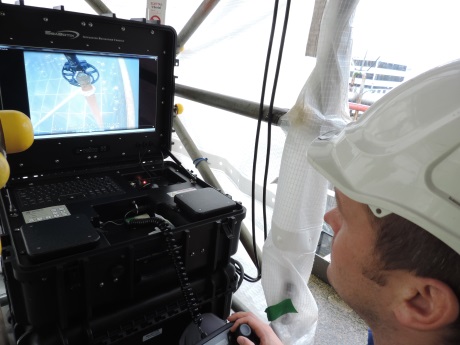Miniature submarines are being used to recover cobalt cartridges dating back to the 1950s from storage ponds at the UK's Sellafield site. The cartridges were used for producing isotopes for medical and industrial applications.
 |
| An operator recovers one of the cobalt cartridges (Image: Sellafield) |
Sellafield Ltd estimates there are some 800 cobalt cartridges being stored in Sellafield's Pile Fuel Storage Pond (PFSP) and First Generation Magnox Storage Ponds (FGMSP), which need to be retrieved.
Head of PFSP Paul Nichol said, "These particular cartridges were irradiated in the early Magnox reactors at Calder Hall and Chapelcross and have been safety stored in the pond since the 1950s and 60s. There are also a small number of cobalt isotopes that were discharged from the Windscale Pile reactors when they were shut down and defeulled after the Windscale fire in 1957."
The isotopes produced using the cartridges had a variety of medical and industrial, including external beam radiotherapy, sterilization of food and weld integrity radiographs.
"It is often forgotten that radiation has many uses outside of the nuclear industry and it has brought many benefits to medicine over the decades," said head of FGMSP Dorothy Gradden. "However, like any nuclear waste, the material still needs to be disposed of in a safety conscious manner, so the same rigorous principles apply."
The cartridges are stored underwater in open-top skips and Sellafield Ltd is using remotely operated mini submarines to retrieve the individual cartridges, which are 1 metre long and weigh around 6kg. The cartridges are being repackaged.
Gradden said, "A few years ago remotely operated vehicles (ROV) were thought of as expensive toys, but they are now becoming an integral part of our plan to clean up our legacy fuel storage ponds." She added, "We have developed the ROV capability to deal with underwater, hazardous problems that need to be dealt with remotely and I'm proud to say that even the US Navy has implemented some of our innovations developed here at Sellafield."
She suggested that potential uses for ROVs at Sellafield could include raising fuel skips and large pieces of equipment from the bottom of the legacy ponds where their cranes cannot reach.
Researched and written
by World Nuclear News





_18570.jpg)
_16159.jpg)
_49205.jpg)





